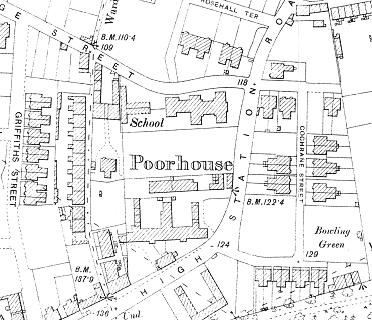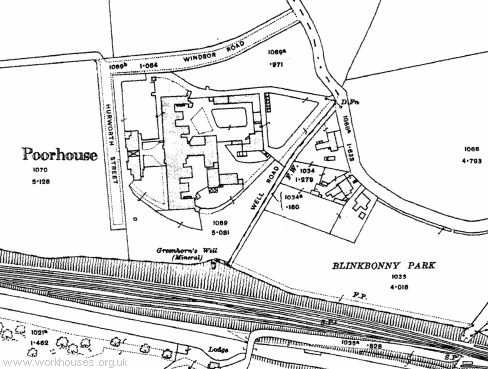Falkirk, Stirlingshire
Between 1845 and 1849, the cost of poor relief in Falkirk rose from £1,400 to around £4,000. As a result the Falkirk Parochial Board decided to erect a poorhouse. The building, which was situated on a 4-acre site in Cow Wynd, opened in January 1850. Shortly afterwards, an additional single-storey section for "lunatic paupers" was built at the rear of the main building. The site location and layout are shown on the 1898 map below.

Falkirk site, 1898
The poor house, or more specifically the lunatic wards, were the subject of an 1857 inspection and report by the Lunacy Commissioners:
1. This Poor House is in situation half way between the railway station and the town, and was erected in 1850 for the accommodation of 200 paupers. At present it contains 130, the highest number hitherto received being 190. The lunatic wards are situated to the rear of the workhouse, and form a separate building, They were opened in 1853, and are calculated for the accommodation of 32 patients. At present they contain 7 males and 12 females.
2. Of these, two male and two female paupers belong to other parishes, and one male and one female patient are paid for by their friends.
3. The charge for patients not belonging to the parish is 6s.6d a week, exclusive of clothing. The actual cost of the inmates overhead, including lunatics, is at present 5s. ½d a week exclusive of clothing. All the pauper lunatics belonging to the parish are in the parish, except one, who is placed with relatives. Acute and chronic cases are alike admitted.
4. The building for the insane is of one storey only, and from being enclosed by high walls, is cheerless and gloomy.
5. The wards for males and females are constructed on the same plan. They each comprise two dormitories for cleanly patients, one for patients of dirty habits, a seclusion room, a day room and an attendants room. The first dormitory in the male department measures 16 ft. long, 9ft., broad, and 11 ft., high, and contains four beds. It is lined with wood, as, indeed, is the house throughout. It is warmed by hot water pipes, which run close to the ceiling, and is ventilated by an aperture in the floor, which communicates by a pipe directly with the external air. In the ceiling are two apertures, through which the impure air escapes into a garret or vacant space under the slates. Partly from the small size of the ventilating apertures, and partly from the surrounding high walls impeding the circulation of the air, the ventilation through out the house is not satisfactory. The hot water apparatus is said to answer well. There are no open fireplaces except in the attendant's room. The windows have iron sashes, and every where throughout the house, with the exception of two, which look into the airing courts, have dead walls within ten feet of them. The bedsteads are of iron, the bedding consists of a straw mattress, chaff pillow, blankets, and one sheet. The beds are clean.
6. The seclusion room is close to the day room, and the house is so badly constructed that one noisy patient is sufficient to disturb all the others. Another error of construction consists in the second dormitory, and the room for patients of dirty habits having been made to open immediately from the day room.
7. The room for wet patients contains three troughs sunk in the floor, over which the beds stand, after the fashion of those in the Glasgow Asylum. These beds are provided with stretched canvas bottoms.
8. The seclusion room measures 9 ft. in length, 6½ in breadth, and 11 in height. It differs nowise from the other, except in the door having stronger fastenings, and the window-shutter locking.
9. The day room is provided with benches fixed round the walls, and contains, besides, one loose bench without a back, and a table. It is clean, but bare and gloomy, from the dead wall standing so close to the windows. There is gas in the day rooms and in all the dormitories. On each side there is a water-closet, warm bath, shower bath and lavatory. The lavatory has only one leaden trough or basin for all the patients. There is no regular time for using the warm bath; the shower bath is occasionally used as a punishment, and also medically, to quiet excited patients. Leather muffs for the hands are in habitual use, and the strait-waistcoat is also occasionally applied.
10. There are two airing courts, each measuring 20 yards in length, by 10 in breadth. The walls are 18 feet high, and completely exclude all view. In the centre of the men's court is a mound about 4 foot high. It was formerly of sufficient height to enable the patients to see beyond the walls, but was lowered in consequence of some patients rolling down the slope in fits, and others shouting to the passers by. Besides these courts, a circumscribed space in front of the house is occasionally used for refractory patients.
11. In the female department, the Matron complains of the impossibility of getting sleep when any patient is noisy. In the largest dormitory, which is 16 feet long, 9 feet broad, and 11 feet high, equal to 1584 cubic feet, there are six beds, so that each patient has only 264 cubic feet of air.
12. The patients in both wards ware clean in their person, comfortably dressed, and their bodily wants seemed well attended to.
13. There are one male and one female attendant, man and wife. The former has £30, and the latter £15 year, with board, lodging, and washing.
14. There is no appointed Chaplain, but Ministers officiate occasionally in the workhouse. The insane paupers do not attend. The only religious service at which they are present, is when the Governor reads to them on Sundays; which he is said to do about once a fortnight,
15. There is a great want of the means of employment. About 1½ acres of land belongs to the house, but one acre is about a mile distant, attached to the fever hospital. The cultivation of this land is reserved to the Lunatics and affords occupation for a week or two in Spring. At the date of our visit, they were without employment of any kind. A newspaper is received, and there are some books; but few of the patients read much. The diet is according to the tables of the Board of Supervision, but the insane and fatuous paupers are said to receive an additional allowance.
16. The Sheriff's last visit was on 2nd April 1855 when he made the following entry:
"Visited the Asylum this day, and found the house in excellent order. Most of the male patients were out at work. It appeared time that the number of female patients was very large in proportion to the accommodation, especially in the sleeping apartments".
17. The Madhouse register and weekly register are kept, and copies of the former are sent twice a year to the Sheriff. There is also a book of certificates of sanity, which are granted by the surgeon, before any patient is discharged. The columns for restraint in the weekly register are carefully filled up. There are two medical attendants, one who is permanent and one who acts more in the capacity of consulting Physician, and is changed every year. The appointment of the latter appears to have been a stipulation by the Sheriff, when the house was licensed. Both medical officers sign the certificates of admissions.
In 1905, a new poorhouse was built on Windsor Road in the Gartcows area.

Falkirk Windsor Road site, 1917
The original poorhouse later became the Woodside Home working men's hostel, and then the County Trades School. The building was demolished in the 1980s. Between the First and Second World Wars, the Windsor Road poorhouse became the Blinkbonny Home, providing accommodation for the elderly, then afterwards joined the National Health Service as Windsor Hospital. The buildings were demolished in 1991.
Staff
Inmates
Records
Note: many repositories impose a closure period of up to 100 years for records identifying individuals. Before travelling a long distance, always check that the records you want to consult will be available.
- Falkirk Council Archives, Callendar House, Callendar Park, Falkirk, FK1 1YR, Scotland. Holdings include Poorhouse plans (various 1848-1901); List of persons receiving relief (September 1850); Report of inspection (1855, typescript copy); etc.
Bibliography
- None.
Links
- None.
Unless otherwise indicated, this page () is copyright Peter Higginbotham. Contents may not be reproduced without permission.


